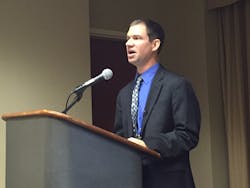INDIANAPOLIS. The long lead time and “flexibility” built into the Phase 2 greenhouse gas (GHG) regulations make them, in the end, “good rules,” at least in the eyes of Daimler Trucks North America (DTNA).
Yet Sean Waters, DTNA’s director of compliance and regulatory affairs, noted in a presentation here during the annual transportation conference hosted by research firm FTR, that traffic congestion in the U.S. will consume the same amount of fuel as the Phase 2 rules will purportedly save over a decade.
“That means we really need better roads and we need to spend money on them,” he stressed. “You can’t get everything you want [in terms of fuel savings] out of [truck] OEMs. We need better roads and infrastructure.”
In terms of generating the fuel savings required by the new Phase 2 rules, Waters pointed out that DTNA is petitioning the National Highway Traffic Safety Administration (NHTSA) – which crafted both the Phase 1 and Phase 2 rules in partnership with the Environmental Protection Agency (EPA) – to get rid of the side mirror requirement for Class 8 trucks.
“That’s a big thing in terms of improving aerodynamic improvement; we can get 1% fuel economy right off the top by doing that,” Waters said.
He added that the key parts making the Phase 2 GHG rules “good” from DTNA’s perspective are its long lead times – with compliance deadlines of 2021, 2024, and 2027 – along with “flexibility” in terms of deploying solutions to meet the rules’ fuel economy targets.
“There are lots of different things we can do; we’re allowed to mix and match features,” he explained. “We are also not forcing customers to buy specific technologies. That’s why we don’t think there will be any ‘cliff events’ or pre-buys due to the rules.”
Waters stressed, however, that this doesn’t mean meeting the Phase 2 GHG goals will be easy – in no small part because it runs to over 1,600 pages in length, with between 4,000 and 5,000 pages worth of supporting documents.
“It will be a challenge; these are tough standards that will cost a lot of money for R&D [research and development] but they are achievable,” he said.
A few other points Waters made in regards to the new rules include:
- While the Phase 1 GHG rules won’t be fully implemented until 2017, they’ve also been “successful” in DTNA’s view. “They’ve been a non-issue, with no impact on customers and no pre-buys. They are a win for the industry and the environment; we’ve been very pleased with them.”
- Waters said the EPA believes the Phase 2 rules should push the “acceptance rate” for automated manual transmissions (AMTs) to near 90% by 2027.
- The Phase 2 rules should encourage broad adoption of engine “start/stop” technology for Class 8 trucks. “That’s one technology that stands out that we haven’t seen in heavy trucks yet,” Waters said. “We’re seeing that a lot in passenger cars. We look forward to seeing it in the Class 8 segment.”
- The EPA is providing an “alternative engine certification pathway” under the Phase 2 rules. Thus if engines are certified to the first stage of the rules in 2020 ahead of the 2021 deadline, they will get “longer credit life” and some relaxation from the 2024 requirements.
- If suppliers can come up with “better technologies” to save fuel as the rules are implemented, they can receive more credits. “That’s a big positive; that will motivate innovation,” Waters emphasized.
- DTNA remains mum on how much extra cost complying with the Phase 2 rules will add to a Class 8 truck’s base sticker price, but Waters noted the EPA’s projection of a two-year payback window for linehaul operations is fairly accurate. “We think that’s a reasonable payback period,” he said. “We think we’ll be delivering a value package that will reduce total cost of operations for the customer.”
About the Author
Sean Kilcarr
Editor in Chief
Sean Kilcarr is a former longtime FleetOwner senior editor who wrote for the publication from 2000 to 2018. He served as editor-in-chief from 2017 to 2018.

